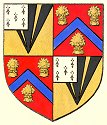 |
A SHORT HISTORY OF TETTENHALL2. The Earliest Times |
|
 |
A SHORT HISTORY OF TETTENHALL2. The Earliest Times |
|
|
The name "Tettenhall" can best be explained as deriving from Teotta's
Halh, a halh being a sheltered position and Teotta being a personal
name, presumably that of the Saxon man who was head of a settlement
which was in a sheltered position. Such a position is that now occupied
by the church and the houses to the east of Lower Green and below the
church which was the original settled area of Tettenhall.
The area is dominated by the ridge which runs from Perton to Aldersley. Below the ridge, the river Smestow, in early times certainly a larger stream than it is now, ran through extensive marsh lands, eventually to join the Severn. Above the ridge there was also a good deal of marshy land but beyond and around was forest. And in that area rose the River Penk, flowing in the opposite direction to the Smestow, eventually to join the Trent.
In Saxon times there seems, to judge by place name evidence, to have
been a fair amount of woodland clearance in the vicinity. The forest,
and the arable and pasture created in woodland clearances, enabled the
settlement to do well and, by 910 AD, it seems to have become the most
notable place for some distance around. For when the old chroniclers
came to describe a bloody and decisive battle which took place in that
year between the Saxons and the Danes, they described it as taking place
at, or near, a place called Tettenhall. The actual site of the battle is
not known but the suggestion is that Tettenhall was the best known place
in the vicinity of the battle and therefore bigger and better known than
Wolverhampton, Willenhall or Wednesfield. |